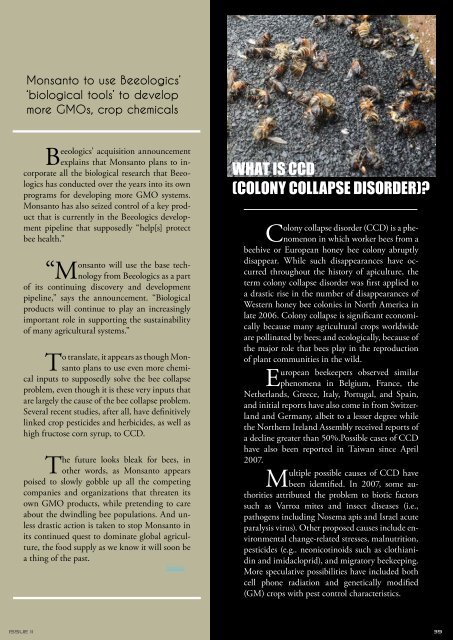You also want an ePaper? Increase the reach of your titles
YUMPU automatically turns print PDFs into web optimized ePapers that Google loves.
Monsanto to use Beeologics’<br />
‘biological tools’ to develop<br />
more GMOs, crop chemicals<br />
Beeologics’ acquisition announcement<br />
explains that Monsanto plans to incorporate<br />
all the biological research that Beeologics<br />
has conducted over the years into its own<br />
programs for developing more GMO systems.<br />
Monsanto has also seized control of a key product<br />
that is currently in the Beeologics development<br />
pipeline that supposedly “help[s] protect<br />
bee health.”<br />
onsanto will use the base tech-<br />
from Beeologics as a part<br />
“Mnology<br />
of its continuing discovery and development<br />
pipeline,” says the announcement. “Biological<br />
products will continue to play an increasingly<br />
important role in supporting the sustainability<br />
of many agricultural systems.”<br />
To translate, it appears as though Monsanto<br />
plans to use even more chemical<br />
inputs to supposedly solve the bee collapse<br />
problem, even though it is these very inputs that<br />
are largely the cause of the bee collapse problem.<br />
Several recent studies, after all, have definitively<br />
linked crop pesticides and herbicides, as well as<br />
high fructose corn syrup, to CCD.<br />
The future looks bleak for bees, in<br />
other words, as Monsanto appears<br />
poised to slowly gobble up all the competing<br />
companies and organizations that threaten its<br />
own GMO products, while pretending to care<br />
about the dwindling bee populations. And unless<br />
drastic action is taken to stop Monsanto in<br />
its continued quest to dominate global agriculture,<br />
the food supply as we know it will soon be<br />
a thing of the past.<br />
Source<br />
WHAT IS CCD<br />
(COLONY COLLAPSE DISORDER)?<br />
Colony collapse disorder (CCD) is a phenomenon<br />
in which worker bees from a<br />
beehive or European honey bee colony abruptly<br />
disappear. While such disappearances have occurred<br />
throughout the history of apiculture, the<br />
term colony collapse disorder was first applied to<br />
a drastic rise in the number of disappearances of<br />
Western honey bee colonies in North America in<br />
late 2006. Colony collapse is significant economically<br />
because many agricultural crops worldwide<br />
are pollinated by bees; and ecologically, because of<br />
the major role that bees play in the reproduction<br />
of plant communities in the wild.<br />
European beekeepers observed similar<br />
phenomena in Belgium, France, the<br />
Netherlands, Greece, Italy, Portugal, and Spain,<br />
and initial reports have also come in from Switzerland<br />
and Germany, albeit to a lesser degree while<br />
the Northern Ireland Assembly received reports of<br />
a decline greater than 50%.Possible cases of CCD<br />
have also been reported in Taiwan since April<br />
2007.<br />
M<br />
ultiple possible causes of CCD have<br />
been identified. In 2007, some authorities<br />
attributed the problem to biotic factors<br />
such as Varroa mites and insect diseases (i.e.,<br />
pathogens including Nosema apis and Israel acute<br />
paralysis virus). Other proposed causes include environmental<br />
change-related stresses, malnutrition,<br />
pesticides (e.g.. neonicotinoids such as clothianidin<br />
and imidacloprid), and migratory beekeeping.<br />
More speculative possibilities have included both<br />
cell phone radiation and genetically modified<br />
(GM) crops with pest control characteristics.<br />
ISSUE II 39






